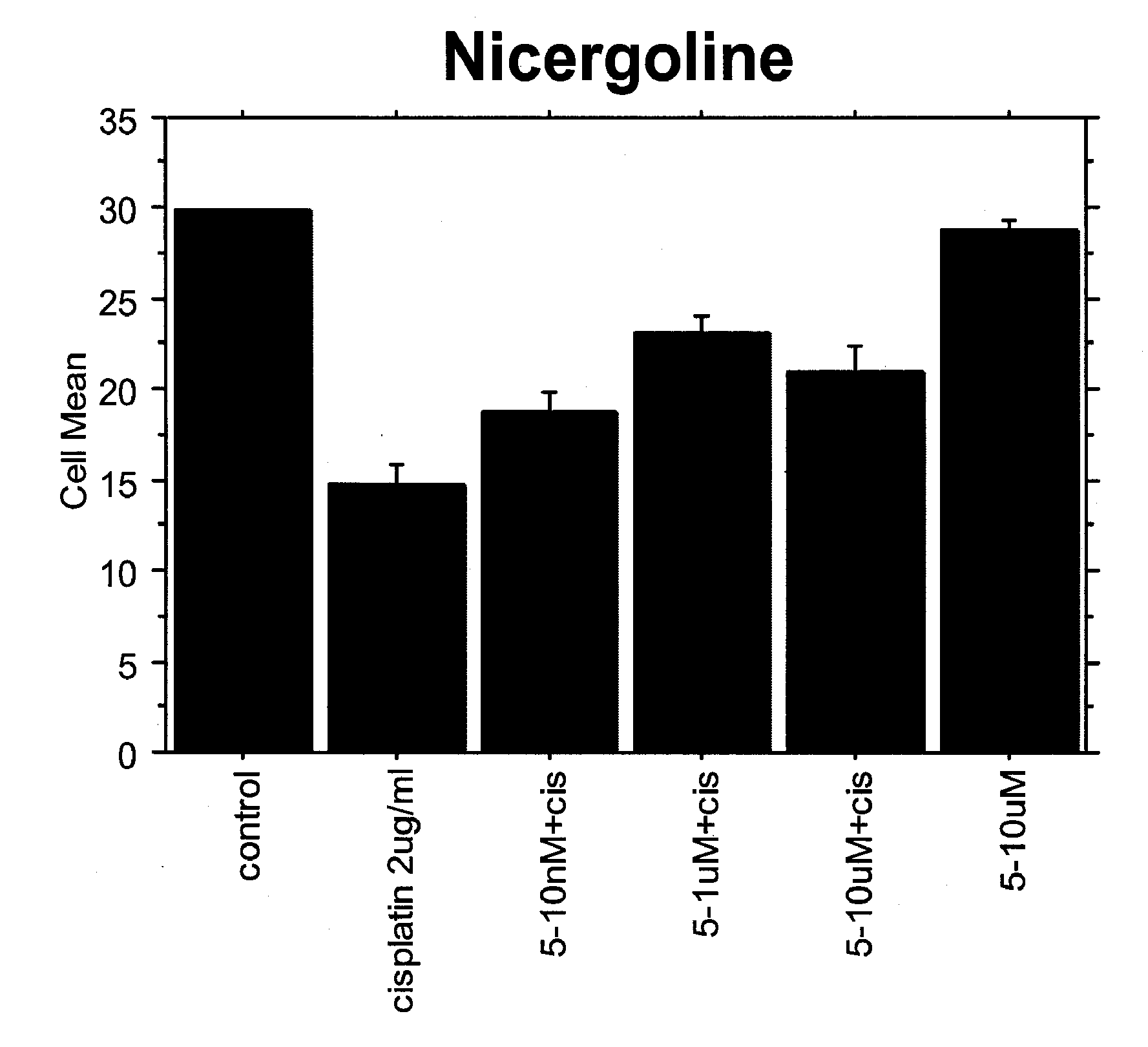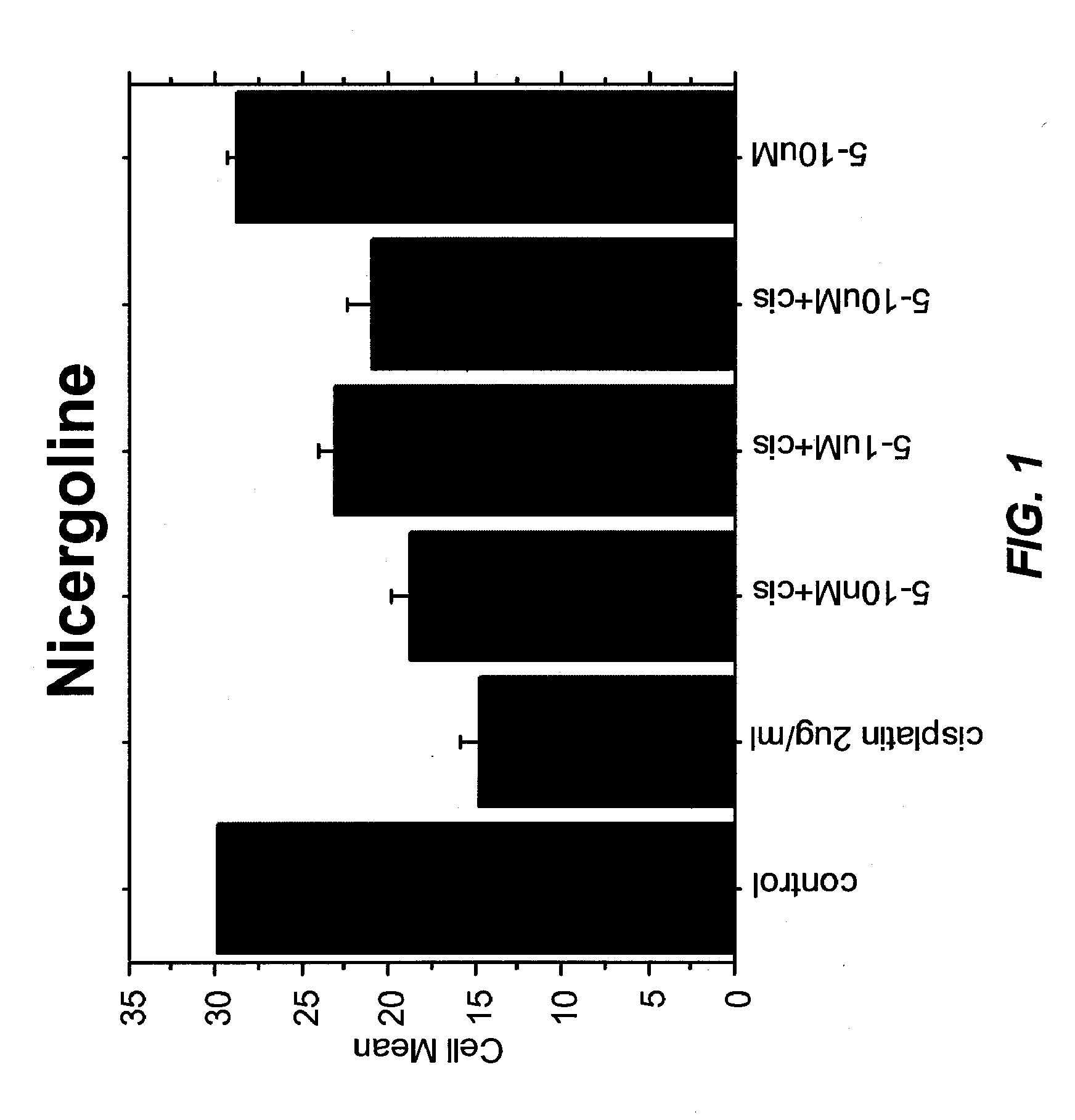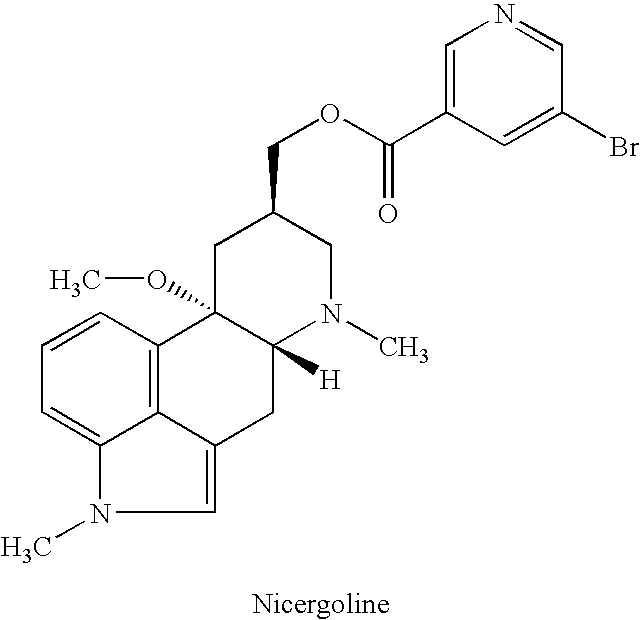Prevention and treatment of hearing disorders
a technology for hearing disorders and drugs, applied in the field of pharmaceutical prevention and treatment of hearing disorders, can solve the problems of complex etiology, perceived hearing loss, and growing problem of hearing loss, and achieve the effect of increasing the efficacy of nicergoline therapy and reducing the variability associated with loss
- Summary
- Abstract
- Description
- Claims
- Application Information
AI Technical Summary
Benefits of technology
Problems solved by technology
Method used
Image
Examples
example 1
In Vivo Efficacy of Nicergoline in the Treatment of Hearing Loss
[0244] In order to demonstrate the efficacy of nicergoline in the treatment and prevention of drug- and noise-induced hearing loss, nicergoline is evaluated in animal models of drug- and noise-induced hearing loss, as described below.
[0245] Experimental Animals
[0246] Male CBA mice, at an initial age of 4 weeks, are purchased from Harlan Sprague-Dawley Co. (Indianapolis, Ind.). The animals are given free access to water and a regular mouse diet (Purina, St. Louis, Mo.), and are allowed 1 week to acclimate before treatment.
[0247] Drug-Induced Hearing Loss
[0248] The aminoglycoside antibiotic kanamycin (700 mg of kanamycin base / kg of body weight twice daily) is tested alone and in combination with various concentrations of nicergoline. The study to evaluate auditory effects is comprised of one group serving as the vehicle control group, one group receiving kanamycin injections only, three groups receiving kanamycin plu...
example 2
In Vivo Efficacy of MMDL and MDL in the Treatment of Hearing Loss
[0256] In order to demonstrate the efficacy of MMDL and MDL in the treatment and prevention of drug- and noise-induced hearing loss, MMDL and MDL are evaluated in animal models of drug- and noise-induced hearing loss, as described in Example 1, above.
[0257] Preparation of MMDL and MDL
[0258] MMDL ((8β)-10-methoxy-1,6-dimethylergoline-8-methanol) can be prepared from nicergoline by hydrolysis of the 5-bromo-3-pyridine carboxylate group from the 8-methanol moiety by a method known in the art. In general, hydrolysis may be accomplished by treatment with acid or base. Heat may be applied to increase the rate of the reaction. Workup may be accomplished by a suitable separation method, such as preparative scale high performance liquid chromatography, thin layer chromatography, separation in a separatory funnel, or other art-recognized method.
[0259] MDL ((8β-10-methoxy-6-methylergoline-8-methanol) may be prepared form nice...
example 3
Cochlear Cultures
[0260] Explants of sensory epithelium from the basal turn of postnatal day 5 (p5) Sprague-Dawley rats were isolated using the methods of Van De Water and Sobkowicz (Van d Water T., Ruben R. J. (1974) “Growth of the inner ear in organ culture,” Ann. Otol. Rhinol. Laryngol., 83:1-16; Sobkowicz H. M., Loftus J. M., Slapnick S. M. (1993) “Tissue culture of the organ of Corti.,” Acta. Suppl. 502:3-36). Explants were maintained in Dulbecco's Modified Eagle's medium with 10% fetal bovine serum and 30 U / ml penicillin. HEPES buffer was added to a concentration of 25 mM and the glucose concentration increased to 6 mg / ml to enhance neuronal survival. Each 15 mm dish containing 250 μl of medium was maintained in an incubator at 37° C. with 5% CO2 and 95% humidity.
[0261] Toxicity-inducers (gentamicin or cisplatin, 1-100 μM) were exposed to the medium 12-24 h following plating for 48 h. Concentrations of gentamicin or cisplatin were employed that produced approximately 50% loss...
PUM
| Property | Measurement | Unit |
|---|---|---|
| Therapeutic | aaaaa | aaaaa |
| Selectivity | aaaaa | aaaaa |
| Disorder | aaaaa | aaaaa |
Abstract
Description
Claims
Application Information
 Login to View More
Login to View More - R&D
- Intellectual Property
- Life Sciences
- Materials
- Tech Scout
- Unparalleled Data Quality
- Higher Quality Content
- 60% Fewer Hallucinations
Browse by: Latest US Patents, China's latest patents, Technical Efficacy Thesaurus, Application Domain, Technology Topic, Popular Technical Reports.
© 2025 PatSnap. All rights reserved.Legal|Privacy policy|Modern Slavery Act Transparency Statement|Sitemap|About US| Contact US: help@patsnap.com



